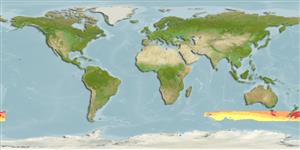Common names from other countries
>
Zeiformes (Dories) >
Oreosomatidae (Oreos) > Oreosomatinae
Etymology: Allocyttus: Greek, allos = other + Greek, kyttaros, kytos = a convex cavity; niger: niger refers to the blackish color of freshly caught specimens. It also reflects the common name "black oreo", which has been widely used in the New Zealand deepwater fishery for several years (Ref. 27159).
Environment: milieu / climate zone / depth range / distribution range
ນິເວດວິທະຍາ
ສັດທະເລ ກ່ຽວກັບ (ຢູ່) ຊັ້ນນ້ຳໃນທະເລເປີດທີ່ປອດແສງສ່ອງເຖິງ; ປາທີ່ມີການເຄື່ອນຍ້າຍໃນສະເພາະມາະຫາສະມຸດ (Ref. 51243); ລະດັບຄວາມເລິກ 560 - 1300 m (Ref. 6390). Deep-water; 43°S - 55°S, 65°E - 174°W (Ref. 27159)
Southwest Pacific: New Zealand and Australian waters south of 43°S, and south of Tasmania at 47°S. Also Ref. 26139.
Length at first maturity / ຂະໜາດ / ນ້ຳໜັກ / Age
Maturity: Lm ?, range 36 - ? cm
Max length : 47.0 cm TL ຕົວຜູ້/ບໍ່ມີເພດ; (Ref. 6390); common length : 35.0 cm TL ຕົວຜູ້/ບໍ່ມີເພດ; (Ref. 9258); ນ້ຳໜັກສູງສຸດທີ່ເຄຍຈັດພີມມາ: 1.5 kg (Ref. 6390); ອາຍຸສູງສຸດທີ່ເຄຍລາຍງານມາ: 100 ປີ (Ref. 27140)
Found close to the sea bed in deep water. Form large shoals over rough ground near pinnacles and canyons. Juveniles are pelagic and inhabit oceanic waters. They tend to be dispersed over smooth grounds (Ref. 6390). Feed mainly on salps and benthic crustaceans (Ref. 27150). Eggs float near the sea surface and larvae also inhabit surface waters (Ref. 6390). Based on trawl catch rates, there is no evidence of vertical migration during day or night (Ref. 27150).
Displays seasonally synchronised reproduction.
James, G.D., T. Inada and I. Nakamura, 1988. Revision of the oreosomatid fishes (Family Oreosomatidae) from the southern oceans, with a description of a new species. N.Z. J. Zool. 15:291-326. (Ref. 27159)
IUCN Red List Status (Ref. 130435)
CITES (Ref. 128078)
Not Evaluated
Threat to humans
Harmless
Human uses
ການປະມົງ: ເປັນສີນຄ້າ
ເຄື່ອງມື
Special reports
Download XML
ແຫຼ່ງອີນເຕີເນັດ
Estimates based on models
Preferred temperature (Ref.
115969): 2.1 - 6.8, mean 5.1 (based on 63 cells).
Phylogenetic diversity index (Ref.
82804): PD
50 = 0.5635 [Uniqueness, from 0.5 = low to 2.0 = high].
Bayesian length-weight: a=0.01413 (0.00715 - 0.02792), b=3.03 (2.85 - 3.21), in cm Total Length, based on LWR estimates for this species & (Sub)family-body (Ref.
93245).
ຊັ້ນເຂດຮ້ອນ (Ref.
69278): 3.5 ±0.50 se; based on food items.
ຄວາມຢືດຢຸ່ນ (Ref.
120179): ຕຳ່ຫຼາຍ, ປະຊາກອນຕຳ່ສຸດທີ່ໃຊ້ເວລາສອງເທົ່າຫຼາຍກວ່າ 14 ປີ (tmax=100; tm=27; Fec >5,000).
Fishing Vulnerability (Ref.
59153): High to very high vulnerability (69 of 100).
Climate Vulnerability (Ref.
125649): Moderate vulnerability (40 of 100).
